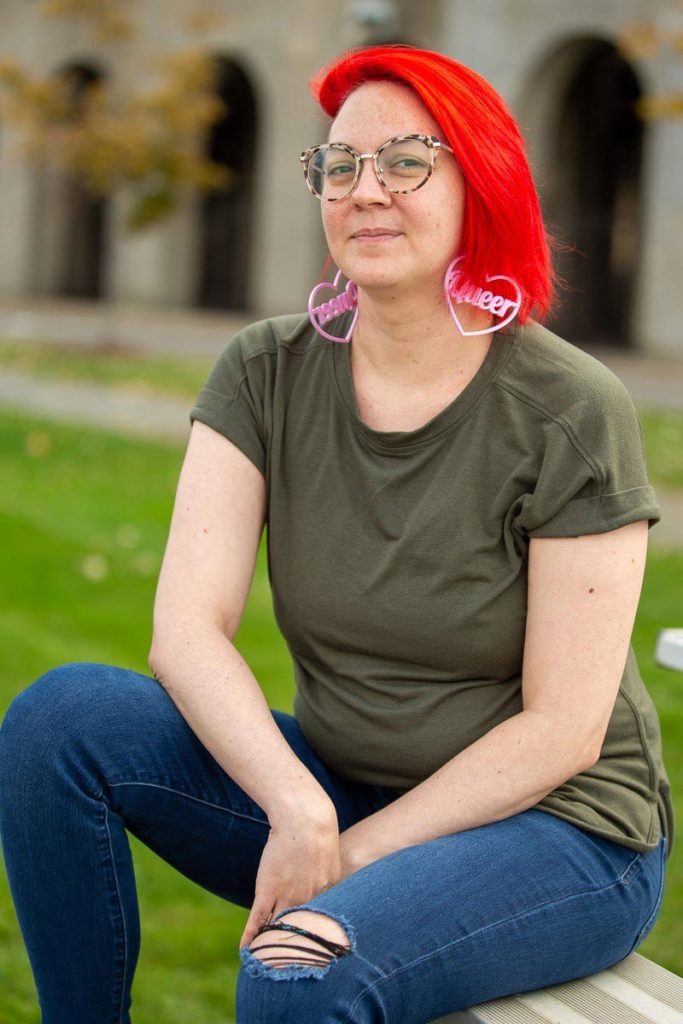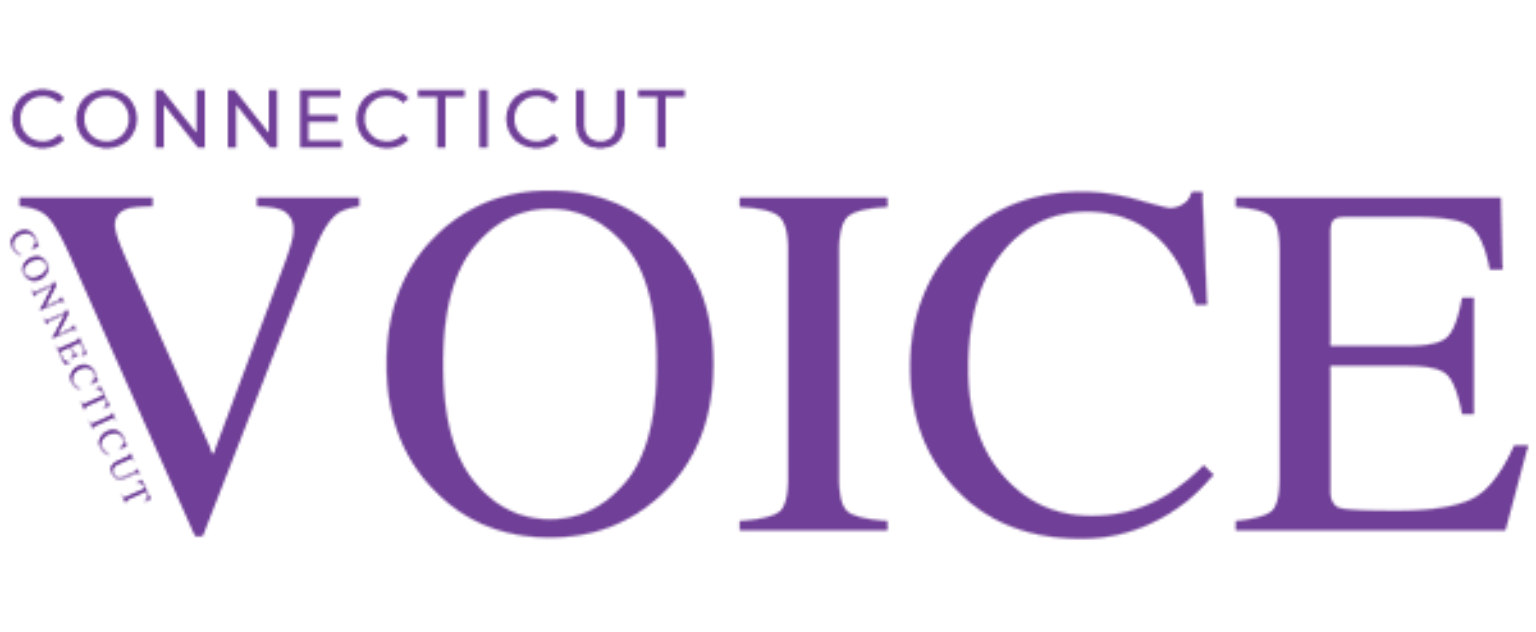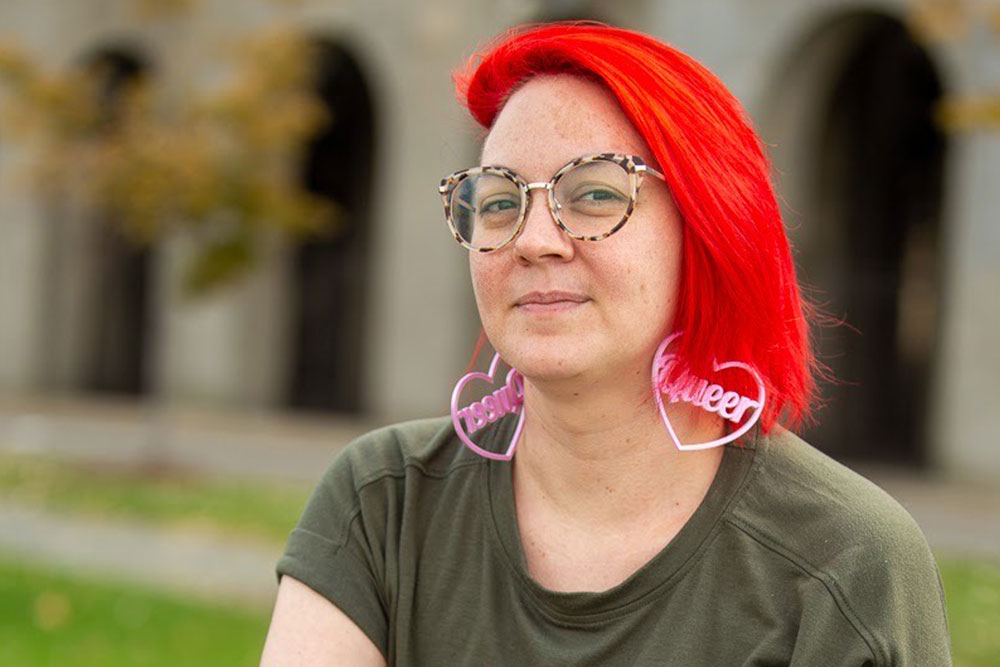Those Who Go By They and Them Share Their Stories
By Dawn Ennis
Let’s start with what nonbinary is not: it’s not a third gender.
Those who identify as nonbinary say their gender identity is best described as part of a spectrum; nonbinary individuals can exist in between male and female and outside of that binary divide. They can be presumed male or female at birth, or intersex.
One of the pre-eminent trans nonbinary journalists, Britni de la Cretaz of Boston, wrote in Sports Illustrated: “‘Nonbinary’ can mean neither man nor woman. It can mean both man and woman. It can mean a million other things in between, each personal to the individual.”
Connecticut, like many states, has come a long way in a short time in recognizing the validity of the nonbinary identity, but there are still hurdles for gender non-conforming individuals who don’t identify as either male or female.
“Nonbinary people live in the gray space,” says trans nonbinary therapist M. Reim Ifrach, 34, who is co-clinical director and art therapist at Lotus Counseling in Watertown. “We’ve created a binary world and we’re telling people there’s actually all this space in between and we all live in it and we might present closer to male or female or androgynous in the middle. But the reality is, when you live life in the gray space, you’re sensitive quite often.”
Ifrach shared some of the art they made displaying that sensitivity, from reacting to the murder of George Floyd to struggles with reproductive organs. The goal of their art? “I just want people to know that our obligation as human beings is to each other.”
“The thing with being out as nonbinary is there’s no one way to look nonbinary,” says Shayn Ember of New Haven. The trans nonbinary neuroscientist is a counselor at Wheeler Health and a volunteer facilitator of the Questioning Gender discussion group at the New Haven Pride Center. “A few times in my life, I’ve had somebody say to me, ‘Wait, are you somebody who I should ask your pronouns?’ And my answer is, ‘You really should be asking everybody.’”
Ember, 34, says poetry they wrote as a young teenager predated their coming out by 11 years: “I’m neither male or female and my body is. And that’s why I don’t like my body and she doesn’t like me.” But without role models or a word to describe them, they languished in their identity for more than a decade, until a college classmate introduced themselves as genderqueer.
“And I was like, ‘What’s that?’” recalls Ember. “‘That’s someone who doesn’t identify as either a man or woman,’ they said. And I was like, ‘Oh, my gosh! That’s me.’”
“I had a teacher tell me that they wouldn’t expect me to use ‘they/them’ pronouns because I wear makeup,” says 16-year-old Naiyah McGlamery of Hartford. Conflicts they and their fellow students had with their high school administration over incidents of racism, anti-Semitism, homophobia and transphobia in school were enough for them to decide to become homeschooled. But that wasn’t all the trans nonbinary student endured.
“I was being constantly misgendered and told my identity wasn’t valid,” they say. “After you come out, you become the ambassador for all people under your identity. I basically educated my entire high school about what it meant to be LGBT.”
“They” and “Them” Are Not New
 July 14 is celebrated around the world as International Nonbinary People’s Day.
July 14 is celebrated around the world as International Nonbinary People’s Day.
Unfortunately, many misinformed folks object to using “they,” “them” and “theirs,” rejecting what they see as a relatively new, politically correct way for someone to identify themselves. The truth is, writers Emily Dickinson, William Wordsworth, Geoffrey Chaucer and even William Shakespeare all used the singular noun “they” in their writing. In fact, The Los Angeles Times reported in 2019 that the use of “they” as a gender-neutral singular pronoun dates back to the 14th century.
“They’re not new, they’re old. They’re very old,” says Ifrach. “It’s kind of like in fashion, right? Every so many years something comes back that used to be around. The pronouns are the same thing.”
However, there are more pronouns to consider than just “they,” “them” and “theirs.”
“Neopronouns” have grown in popularity and merited a recent article in The New York Times. A neopronoun is a word invented to serve as a pronoun without signaling gender, like “ze” and “zir.” Other variations include “hir,” “zirs” and “hirs.” There are even those who use “it” and “its.”
The Anti-Defamation League, which fights all forms of hate-speech, provides a guide to pronouns, as does GLSEN. Typically, nonbinary people embrace a variation on “they,” “them” and “their,” but some combine traditional pronouns like “he” and “she.” Transgender, nonbinary WNBA player Layshia Clarendon’s pronouns are interchangeably “he,” “she,” “his,” “hers,” “they,” “them,” “theirs.”
“I’ve always known I was more than just a girl or a woman, but I didn’t know what exactly I was,” Clarendon told de la Cretaz in Sports Illustrated. “And so, identifying as nonbinary and trans in terms of the larger umbrella is really important to me. That gives me a place to belong and gives me community.”
Clarendon has shared much of her identity journey with her followers on Instagram, from declaring “There’s no one way to be trans” when they came out as trans and nonbinary in December, to the birth of their child and their top surgery in January.
But medical transition — taking feminizing or masculinizing hormones or undergoing gender-affirmation surgery — is not always the next step after coming out nonbinary, just as with many trans people. According to the 2015 U.S. Transgender Survey by the National Center for Transgender Equality, only 25% of respondents reported having some form of transition-related surgery, often because of a lack of insurance coverage, or poverty, in addition to those who don’t want to undergo surgery. Only 9% percent of nonbinary individuals were likely to have had any kind of surgery, compared to 42% of trans men and 28% of trans women respondents. So it should be no surprise that for nonbinary individuals, medical transition is entirely optional, and more often than not an option not chosen.
Transgender and Nonbinary: Connections and Disconnections
Some people who are nonbinary identify as transgender and nonbinary; others use only “nonbinary” as their identifier. The reason why is individual and personal.
“I think it’s up to each person to decide which words they use to describe themselves,” trans nonbinary journalist de la Cretaz says. “Personally, I define transness as inclusive of anyone who doesn’t identify with the gender they were assigned at birth, which includes nonbinary folks. But I can’t claim identity for anyone else; it’s up to each person to decide for themselves.”
GLAAD Rapid Response Manager Mary Emily O’Hara of Portland, Ore., uses “they” and “themme” pronouns and is one of several prominent LGBTQ media people to publicly announce they identify as nonbinary this year. But O’Hara is one who does draw a distinction between nonbinary and trans.
“I identify as nonbinary, and as a lesbian or dyke since that is my primary community. I don’t identify as trans, because I am not trying to change my gender or body to something other than what it is, if that makes sense. I am gender fluid and have expressed my gender differently throughout my life starting with childhood,” they say. “I have enjoyed being seen as a boy and as a girl at different times in my life, and my expression of masculinity and femininity changes internally and externally by the day or even hour.
“While I do sometimes experience gender dysphoria, I don’t feel that I carry the same burden as my trans friends who experience a LOT of dysphoria, a strong identification with a gender, and who pursue medical treatment like blockers, hormones, or surgeries, and so it doesn’t feel appropriate to me to claim the trans label,” O’Hara continues. “I obviously share some experiences with my trans friends, like being misgendered every day, but there are others that I don’t share—and it’s important to me to respect those subtle differences.”
Sarah Strong of Hamden, 53, teaches creative writing at Central Connecticut State University and at the University of Hartford, and identifies as bisexual and nonbinary. “They” and “them” pronouns fit Strong best, but they do not feel they are transgender.
“The formulation of cis and trans is a binary gender system and – no shade at all for people who that works for – for me it feels too much like being asked to pick a side,” says Strong, who added that they tried being a lesbian, “but it didn’t work because I wasn’t one. While I would never say ‘never’ about an identity, to me, it doesn’t feel accurate, because, again, the thing that makes me nonbinary is that I don’t identify with a binary gender system.”
Historic Moments
In January 2020, nonbinary friends Dr. A.J. Eckert of Glastonbury and Lindsey Pasquale of Columbia learned Connecticut was joining the 19 other states and Washington, D.C. in allowing drivers to change their gender marker on their licenses to “X.” They jumped at the opportunity.
“The DMV let me know that I was the first person in CT to get my X Marker — very exciting!” says Eckert, who is the medical director in charge of Gender and Life Affirming Medicine at the Anchor Health Initiative, which has offices in Hamden and Stamford. While the DMV couldn’t confirm that for reasons of privacy, Deputy Commissioner Tony Guerrera says how important making the X Marker available is.
“This was one of my top priorities for the agency,” Guerrera says in a statement. “Giving residents the opportunity to secure identification that accurately reflects their gender was a significant milestone for the DMV, and a step forward towards creating a culture of inclusiveness.”
Pasquale explained in a Facebook post why this was so important to them: “This was a really serious and affirming thing. I had more than a few conversations with my wife, going back to when different laws were being proposed last legislative session” they wrote. “For today, or at least the next few hours, I’ve given myself permission to just sit back and enjoy feeling the validation and gender euphoria.”
How Being Nonbinary Impacts A Relationship
Pasquale is PFLAG’s treasurer and serves as a member of its board of directors, as well as being a New Haven Pride Center board member. They also manage Facebook groups for nonbinary folks, totaling nearly 40,000. They are married to Deb, a straight woman, and as a couple they face the same stigma as bisexual men and women and couples that include binary transgender people: presuming that loving someone bi, nonbinary, trans or trans nonbinary changes that person’s orientation.
“You don’t get to tell someone else what their identity is,” says Pasquale, in response to a question about their relationship. “My wife and I have been married 32 years. We’ve built a life together. We’ve been there for each other for the good times, but also some really dark ones, including the loss of a child.
“Along the way, my wife consciously came to terms with her definition of happiness, including me,” they say. “We both put in the hard work and were honest with each other and ourselves along the way. But none of this changes who my wife is. My wife is as cisgender and heterosexual as she’s always been. When pushed for a label, we both joke that she is ‘Me-Sexual.’ The truth is that relationships are complicated and the heart wants what the heart wants. I’m so glad that my wife’s heart happens to be kind of fond of me.”
Other nonbinary folks, like Ember of New Haven, expressed frustration at how legal systems still get in the way of their being able to live like everyone else. They are in a relationship with a cis lesbian in New York, and they’re considering having a baby together with a sperm donor. But because Connecticut and their home state are not as progressive as they need it to be, they face big decisions.
“If I have the baby in Connecticut, then they’ll put me as the mother on the birth certificate,” and not their partner, Ember says. “But if we drive across the border to New York where she lives, then it will be ‘Parent One’ and ‘Parent Two.’ Because I’m from Oklahoma, I can’t change my birth certificate to X, I can only change it to ‘M‘ or leave it as ‘F.’ And so even though my driver’s license is ‘X,’ my passport can’t be X, my birth certificate can’t be X, and when I want to have a baby, when I want to get married, all of these things, there’s not a space for us yet.”
Says McGlamery: “One thing that I wish people knew about being nonbinary, and about being trans in general: If someone you know comes out to you as trans, they’re not a different person. They’ve been that person all along. They’re just making your view of them more accurate. I’m exactly who I am. I’m still Naiyah, I’m just Naiyah with they/them pronouns. I’m not a different person. I’m just showing you more accurately who I am.”
Footnote
Gov. Lamont just signed a bill into law, on May 20 and you can view information on the bill here.










More Stories
How Can They Keep from Singing?
“My anger problems became a success” – Artist Diane DiMassa on the Collection of her Classic Underground Comic
Connecticut Sun: Playing for Good